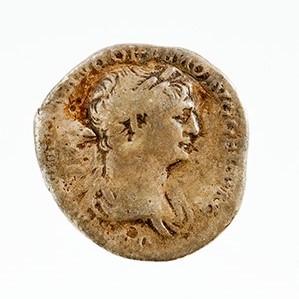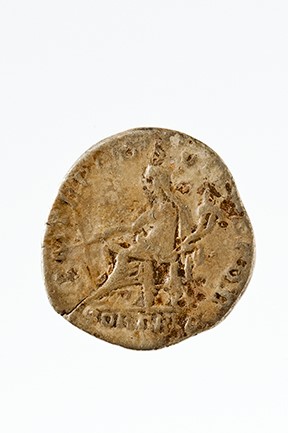Acquisition number: 1965.07
Obv.: Bust of Trajan r., laureate, draped. [IMP(eratori) CAES(ari) NER(uae)] TRAIANO OPTIMO AVG(usto) GER(manico) DAC(ico).
Rev.: Fortuna seated l., draped, veiled, holding a rudder in right hand and cornucopiae in left. P(ontifex) M(aximus) TR(ibunicia) P(otestate) CO(n)S(ul) VI P(ater) P(atriae) S(enatus) P(opulus) Q(ue) R(omanus). In exergue, FORT(una) RED(ux).
Title: Denarius of Trajan - 1965.07
Acquisition number: 1965.07
Author or editor: Beryl Rawson
Culture or period: Roman Imperial
Date: AD 116
Material: Metal - Silver
Object type: Coins - Roman
Dimensions: 19mm (w)
Origin region or location: Italy
Origin city: Rome
Display case or on loan: 7
Keywords: Coin, denarius, Roman, Imperial, Trajan, Fortuna
Seaby, H.A., Roman Silver Coins (London, B.A. Seaby, 1967) 154; Mattingly, H.,Coins of the Roman Empire in the British Museum, 6 vols (London, 1965) 578, St. 235; Robertson, A. Roman Imperial Coins in the Hunter Coin Cabinet, University of Glasgow 5 vols (Oxford: Oxford University Press, 1962-1982) II 30 no. 187 and pl.6.
1965.07
Denarius of Trajan
2.769 g. AD 116
Obv.: Bust of Trajan r., laureate, draped. [IMP(eratori) CAES(ari) NER(uae)] TRAIANO OPTIMO AVG(usto) GER(manico) DAC(ico).
Rev.: Fortuna seated l., draped, veiled, holding a rudder in right hand and cornucopiae in left. P(ontifex) M(aximus) TR(ibunicia) P(otestate) CO(n)S(ul) VI P(ater) P(atriae) S(enatus) P(opulus) Q(ue) R(omanus). In exergue, FORT(una) RED(ux).
Trajan’s sixth and last consulship was in AD 112, so this coin belongs to the period 112-117. He had the title ‘Germanicus’ from AD 97 and ‘Dacicus’ (for Dacian victories) from AD 103. The title ‘Optimus’ (the best), used on coinage from AD 104 onwards, became part of his formal title on the obverse from AD 114 or 115. Trajan was away from Rome in the East from AD 113 to his death in 117. The title ‘Parthicus’, for Parthian victories, dates from AD 116, so this coin is earlier than that. The reverse legend ‘Fortune the Bringer-home’ appears only on Trajan’s later coins and thus is probably associated with Trajan’s absence on the Parthian campaign.
Seaby, H.A., Roman Silver Coins (London, B.A. Seaby, 1967) 154; Mattingly, H.,Coins of the Roman Empire in the British Museum, 6 vols (London, 1965) 578, St. 235; Robertson, A. Roman Imperial Coins in the Hunter Coin Cabinet, University of Glasgow 5 vols (Oxford: Oxford University Press, 1962-1982) II 30 no. 187 and pl.6.

